How are you currently communicating with your customers?
If calling, emailing, or submitting a form on your website are the only means for your customers to reach you, you need to get with the times and make some changes.
Offering live chat on your website is a better way to provide customer service.
According to studies, 73% of consumers say live chat is their most preferred method of communication.
This ranked highest compared to other methods. In fact, 61% of consumers said they preferred email, 48% preferred social media and only 44% preferred phone.
Furthermore, live chat had a 92% satisfaction rating.
This was also the highest satisfaction rating compared to other forms of customer support.
It’s clear your company needs to have this feature on your website. But how do you implement it? You’ve got two choices: chatbots or live chat representatives.
Chatbots are computer-generated responses. They allow customers to receive answers to their questions via AI software.
Experts predict that by 2020, 85% of consumers will be able to manage their relationships with brands without human interaction.
And 80% of businesses are either currently using AI or planning to use AI for customer service in the next two years. Further, 45% of customers say they prefer chatbots for customer service inquiries.
With this technology on the rise, you need to have marketing skills to survive in the age of AI.
Grand View Research expects the global market size for chatbots to hit $1.25 billion by the year 2025, with a 24.3% compounded annual growth rate.
You need to decide whether you will use chatbots or an actual human to type responses to customers on your website.
People ask me which option is better all the time. The reality is each one has its pros and cons.
Chatbots and live chat representatives work well together. I’ll explain when it’s best to use one over the other in this guide.
I’ll go through some factors and scenarios to help you decide the best fit for your website.
Response time
You don’t want to make your customers wait. That’s a big problem when it comes to customer service.
We’ve all been there—sitting on hold on the phone for what feels like a lifetime waiting to talk to someone.
Live chat drastically reduces wait times. In fact, 79% of consumers say they prefer live chat because they get their questions answered immediately.
Just look at these average response times of live chat compared to social media and email:
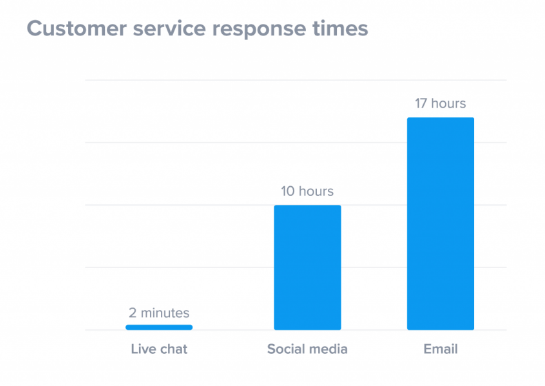
Live chat blows these other methods out of the water in terms of speed.
But it’s still not perfect.
Believe it or not, 21% of live chat support requests are ignored by businesses.
While live chat has a fast response time, it can still be improved.
On the other hand, chatbots have an instant response. Upon a customer posting an inquiry, a chatbot can generate an answer within seconds. This gets the conversation going right away.
If you’re looking for the fastest response times, chatbots win. But live chat will still be faster than the other options you’re using.
My recommendation is to use a combination of the two options.
When a customer begins a chat session, start with a chatbot to give them an instant reply. This bot can gather preliminary information about the inquiry until a representative becomes available.
Chatbots can also make sure the customer gets transferred to the right representative who is qualified to answer their question.
I’ll talk more about how chatbots and live chat representatives can work together further in this guide.
Cost efficiency
Your business decisions need to be cost-effective. Live chat will help reduce costs compared to phone support.
In fact, studies show that it’s 17-33% less expensive to communicate with a customer via live chat than phone calls.
Live chat agents have the ability to multitask and help several customers at the same time. This can’t be done over the phone.
Implementing live chat will improve your operational efficiency.
You’ve got to determine how much this new technology will cost you. Here’s a look at some average prices to give you an idea of what to expect:

The pricing will depend on many factors, such as the number of agents you’re paying and the times they’re available.
It will also vary depending on whether you’re paying staff in-house to handle these inquiries or outsourcing this service to a general customer service agency.
If you’re paying more than $20 per month per user, I’d say that’s expensive.
Outsourcing support to a customer service agency will be cheaper, but you may lose some quality of the responses compared to those given by one of your own employees.
How many employees will you need to handle your live chat communication?
Research shows 51% of businesses have just one agent dedicated to live chat. And 39% of companies have between two and five agents.
That’s not surprising, considering 70% of brands that implement live chat have less than 5,000 unique website visitors each month.
And we know that 52% of companies say price is the most important factor influencing their decisions to use live chat.
Chatbots will lower these costs.
Sure, you’ll need to pay for the AI software. But this will definitely cost you less in the long run compared to paying employees in addition to the cost of the live chat software.
If you’re looking for the cheapest option, you’re better off with chatbots.
But using human reps to respond via live chat is still cheaper than phone support.
Human touch
Artificial intelligence is definitely advancing.
Responses by chatbots can mimic human answers. In some instances, customers won’t even notice they talk to a robot.
That said, chatbots can’t replace that human touch.
There is still some resistance from customers when it comes to using chatbots:
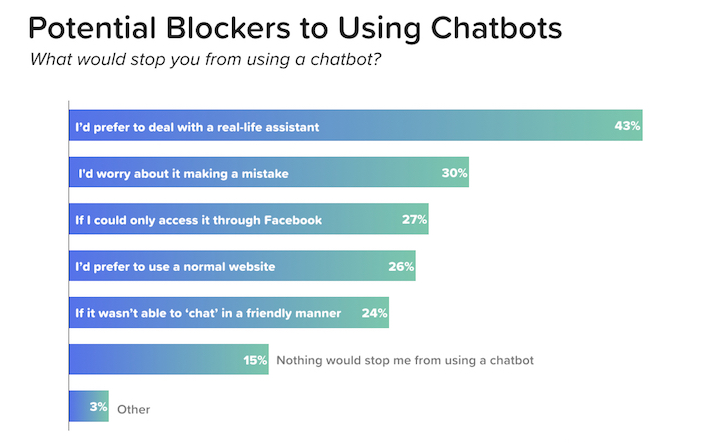
As you can see, people have their reservations about using this new technology.
There are times when customers would rather deal with an actual person. Consumers are also worried about chatbots making a mistake.
About 37% of consumers expect to use a chatbot for getting a quick answer in an emergency.
For example, a chatbot could help someone determine whether an item is in stock or help track the shipping of their package.
And 34% of people say they would use a chatbot to help them find a customer service associate. This echos my earlier point about the two options working well together.
Based on what the customer is looking for, the chatbot can appropriately direct them to an agent. For example, a sales inquiry may go to one department, and a question about technical support may go to a different department.
Start with a chatbot, then transfer the customer to a live chat session with an actual human.
Availability
If you’re going to use humans on your website to chat with customers, they’re probably not going to be available 24/7.
This is especially true if you’re planning to use your employees to handle these chats. Your costs will be significantly higher if you’re paying for human support 24/7, 365.
Giant global corporations such as Apple can afford this, but smaller businesses cannot.
That’s when you’ll need chatbots.
The number one potential benefit of using chatbots is 24-hour customer service.

Chatbots can respond to customers in the middle of the night as well as on weekends.
That’s because chatbots don’t need to eat, sleep, or take bathroom breaks.
To maximize your availability and provide 24-hour service without paying extreme labor costs, use chatbots.
Even if you use human representatives during business hours, you can switch to chatbots when your customer support agents are offline.
Resolving inquiries
Fast response times are important. Being able to get an answer at any time of the day or night is a great benefit as well.
But these are useless if the customer inquiry isn’t resolved.
That’s why they’re reaching out in the first place. The customer has a question or a problem that needs to be addressed.
Most people would assume a human representative is the only way to solve a customer problem. However, that’s not always the case.
Research shows that eight out of ten chat sessions can be resolved by a chatbot.

Chatbots aren’t perfect: 20% of these sessions don’t end in a resolution.
It’s nearly impossible to please 100% of your customers. However, you want that number to be as close to 100% as possible.
In some instances, a chatbot can transfer the conversation to a customer service representative.
Those agents will be able to do things that chatbots aren’t capable of yet, emphasizing the need for the human touch.
Chatbots can’t feel empathy or convey a specific tone the same way a human can.
A chatbot won’t give customers the right response if it doesn’t understand what they’re asking.
Here’s an example of that:
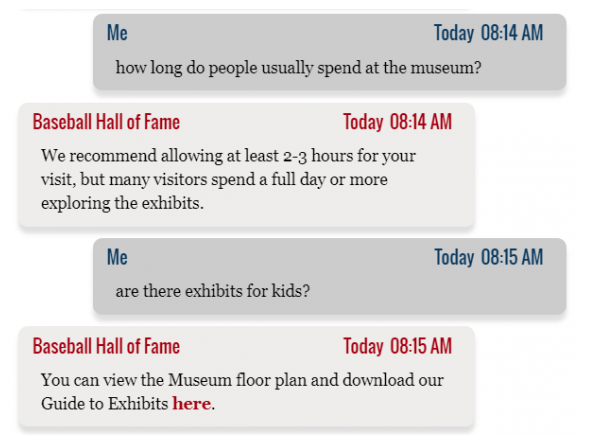
As you can see, the chatbot provides useful information. The first question gets answered appropriately.
But the second question doesn’t get answered properly.
Chatbots could also run into problems if the customer’s query has spelling and grammar issues.
If a customer is looking for help with something like custom pricing based on their unique situation, a chatbot may not be able to provide them with the assistance offered by an actual person.
Can a chatbot resolve inquiries? Absolutely.
However, at times you’ll need to transfer those inquiries to a human.
Again, this highlights the fact that chatbots and live chat work well when paired together.
Conversions
Ultimately, you want your customers to convert after reaching out to your customer support via whatever option they choose.
Live chat increases the chances that people will buy:
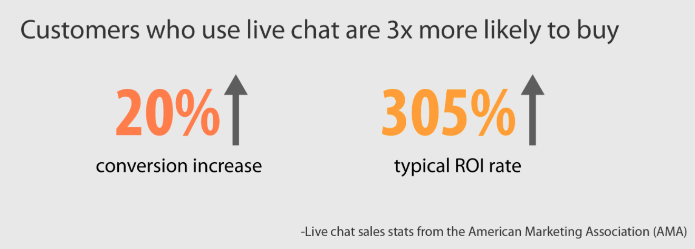
In fact, 38% of consumers will make purchases on ecommerce websites as a direct result of their live chat sessions.
Live chat is a great way to drive conversions. That said, live chat isn’t proactive.
Allow me to explain.
Once a site visitor determines they want to use live chat to solve their problem, they need to make an effort to reach out. As a result of the conversation, they’ll be more likely to convert.
But the visitor needs to make that initial step.
It’s obviously unreasonable for a human agent to reach out to every person who lands on your website.
That’s when you can use a chatbot to be proactive. Here’s an example from the Levi’s website:
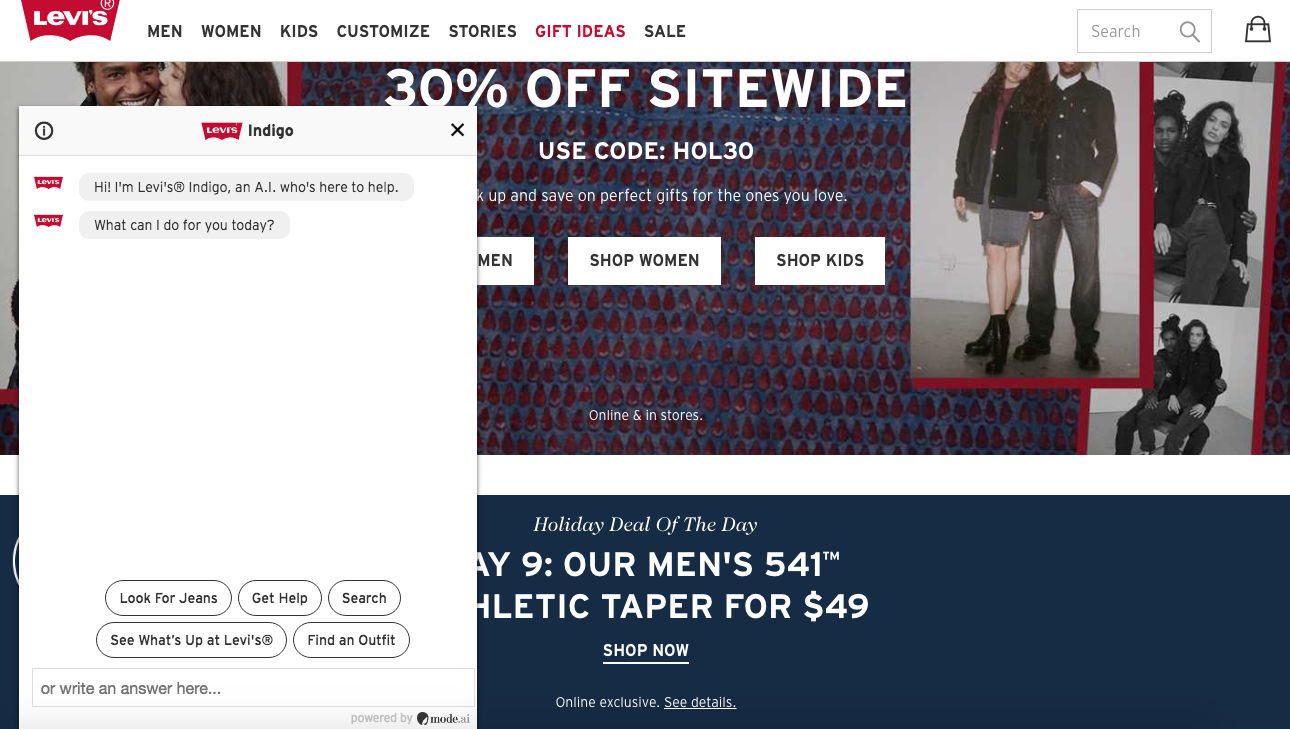
When a customer lands on this website, an AI chatbot automatically starts a chat session.
This is proactive.
Now, if a customer has an inquiry, they’ll be more inclined to take advantage of this feature. If the chatbot is unable to resolve the problem, the chat can be transferred to a human representative.
Conclusion
Your business can provide better customer service by implementing live chat.
Now you just need to determine whether you’re going to use human representatives or chatbots to handle this communication.
Chatbots will provide an instant response, but live chat agents are still faster than your current methods of customer support.
Live chat representatives are less expensive than phone calls from customers, but chatbots will be cheaper in the long run.
However, chatbots don’t add a human touch to the conversation.
Chatbots are available 24/7, which won’t be the case for actual agents.
Surprisingly, bots are able to resolve the majority of customer inquiries. Both live chat agents and chatbots increase the chances of getting customers to convert.
Ultimately, live chat and chatbots work best when they’re implemented together.
I recommend you use both of these on your website to maximize efficiency and get the best results.
Are you planning to use chatbots, live chat agents, or a combination of both to improve customer communication on your website?
